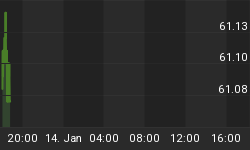The following is an excerpt from Pivotal Events published for our subscribers October 19, 2017.
Perspective
The headline about the cost of not being fully invested was from the manager at JP Morgan Asset Management who added "I've never been so optimistic about the global economy."
We are still disturbed by last week's observation from a very big money manager that the main risk is "policy error" by the Fed. This could be based upon 2007, when there was adamant conviction that the Fed, in making the perfectly-timed "cut" in the administered rate, could keep the mania going. One conclusion could be that the Fed's timing was not perfect and was an "error". The more practical observation is that the T-bill rate always plunges during a post-bubble collapse and the Fed rate follows the market rate of interest. Down.
T-bill rates, or equivalent increase in a boom and decrease in the consequent contraction.
And then there is the comment about creating new kinds of financial instruments. Which is a sign of speculation, but we do not know of any "alarm bells" at the Fed. Wild, but ephemeral financial instruments have been created with every great bubble since the first one in 1720.
Stock Markets
A year ago, going into the US election financial markets were unsettled. Part of the decline was political and the other was seasonal. Pressures in the stock market were sufficient to prompt a ChartWorks "Springboard Buy" on November 3rd. The market was poised for a rebound and the prospect of a pro-business administration launched the rally on November 7th.
In December, we began calling it "Rational Exuberance". With the momentum readings in June we called it just "Exuberance". As outlined below, this could get into "Irrational Exuberance".
We see big names out there, such as Stockman, offering many alarms based upon government financial excesses. But the stock market is its own master. And then there is Krugman, for whom the most reckless central banking in history is not enough to fit his Keynesian concerns. For some weird reason the concern is that the rate of CPI inflation must be kept above 2 percent. There are many perma-bulls who consider that "Rosy Scenario", "Lady Bountiful" and Janet Yellen are there personally to look after their portfolios.
Let's review how we got this far and just how this speculation could end.
The most recent in the series of Sequential Buys, which is our "Buy-the-Dip" model, was on the Nasdaq on the slump into August at 6177. The rally has made it to 6633 and we are now wondering, in the absence of credit adversity, how far this strength can run.
This week's action in the DJIA as well as the S&P has generated Upside Exhaustions on the Daily and Weekly readings. Previous such examples occurred somewhat before the peaks in 2000 and in 1987. Of course, the lead time on this set can't be known. Hot action in stocks and industrial commodities likely into September has continued into October. In so many words, our September target got us this far.
The flattening yield curve, which is supportive to the boom, is now out to the time window when it can reverse. And as noted last week this could be in or around November. The second attempt, as we have been noting, to reverse spreads to widening stalled out.
It is one thing to have a sudden "outlier" appear in the markets when the action is oversold, as with last November's election. It is something else when the "outlier" that tax reform could advance when the stock market is cyclically expensive. The "outlier" could be the Republicans taking a significant step in reducing tax rates.
Independent of this is that the DJIA looks as if it wants to go into the bubble-climax mode. In which case when will its elastic limits be reached?
Ross has a chart overlaying the action in the DJIA, now, with the dramatic conclusion to the Nasdaq's Dot.Com Bubble in March 2000. The record shows a series of Upside Exhaustions. As with grand events, the phenomenon is recognizable, but the height and duration of the concluding spike can't be determined ahead of time. It is, however, satisfying to identify it as it brews up. One timing model comes to mind.
Some great speculations have completed at the end of the year or into January.
These include the S&P on January 11, 1973. Gold on January 21, 1980 and the Nikkei right at the end of 1989.
These dates provide a probable target for the peak, which is more than two months away. In the meantime, anything can happen, but any shocking "news" could be led by changes in the credit markets.
Listen to the Bob Hoye Podcast every Friday afternoon at TalkDigitalNetwork.com
















